Just like us, reptiles can face health challenges. Bearded dragon tail rot is one such condition bearded dragon owners should be aware of. Tail rot is a reptile health condition. In tail rot, the reptile’s tail undergoes decay or necrosis due to various factors such as injury, infection, or poor hygiene.
In this article, we will explore the symptoms of tail rot, including a darkened tail and potential internal infection. We’ll also discuss the importance of a proper diet, as improper diet and nutrition can contribute to blood clots and internal organ issues.
Additionally, we’ll delve into the treatment options available, and health concerns, including the use of topical medication and warm water soaks for pain relief. So, let’s dive into this common condition and equip you with the knowledge to ensure your bearded dragon’s tail remains healthy and vibrant.
Bearded Dragon Tail Rot: Causes, Symptoms, and Treatment
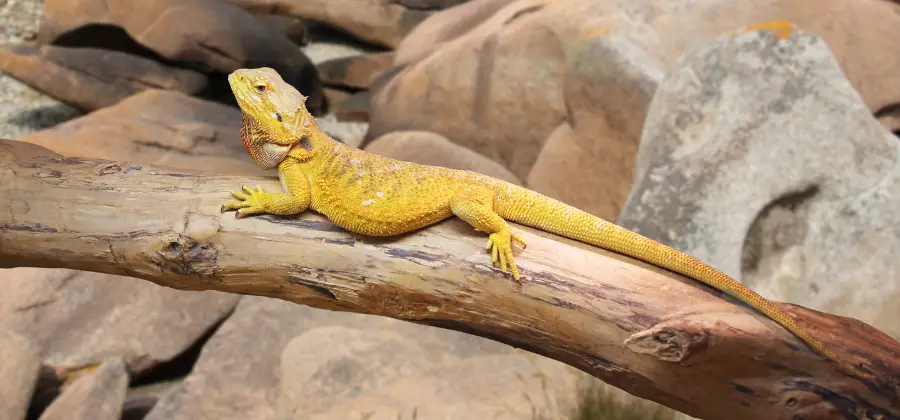
Bearded dragons are popular reptile pets known for their distinctive appearance and friendly demeanor. However, like any pet, they can be susceptible to various health issues, one of which is a condition known as tail rot.
Tail rot, as the name suggests, is a progressive deterioration of the tail tissue in bearded dragons, generally starting at the tip and moving upward if left untreated. This condition can lead to serious complications and may require amputation if not addressed promptly.
Several factors, including improper husbandry, trauma, and infections, can cause tail rot in bearded dragons. Poor hygiene and unclean living conditions may facilitate the growth of bacteria or fungi that contribute to this condition.
Additionally, injuries to the tail, whether accidental or self-inflicted, can expose the inner tissue to infections and lead to tail rot. Keeping bearded dragons in an appropriate and clean environment is key to preventing the development of this ailment.
Early detection and intervention are essential in managing bearded dragon tail rot. Some common symptoms to look for include a darkening or blackening of the tail tip, dry or flaky skin, and swelling or inflammation.
If you suspect your bearded dragon may be suffering from tail rot, it is important to consult a veterinarian with experience in reptile care. They can provide an accurate diagnosis and recommend an appropriate course of treatment to prevent further complications.
Signs and Symptoms of Tail Rot
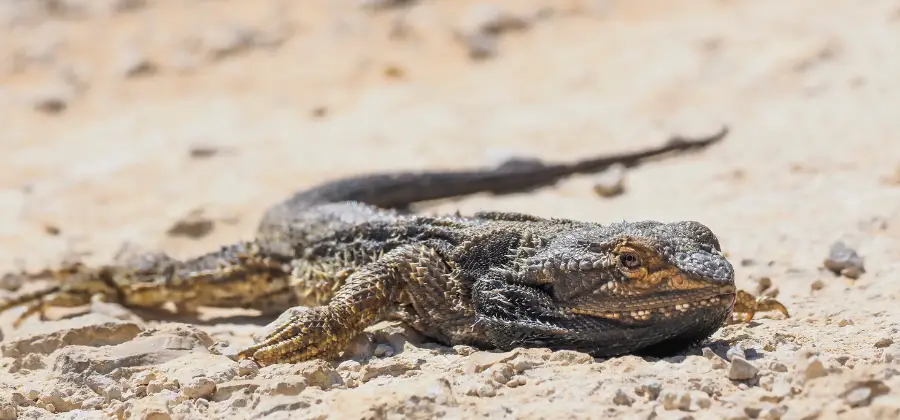
Tail rot is a common issue that affects bearded dragons, and it’s important to recognize the signs and symptoms to ensure your pet gets prompt treatment. This condition occurs when blood flow to the tail is compromised, leading to tissue damage and, if left untreated, potential loss of the tail. Here are some key indicators to watch for:
Discoloration
One of the first signs of tail rot in bearded dragons is a change in color on the distal limbs and tail. The affected area may appear darker, often turning black. This discoloration is a result of limited blood flow causing tissue necrosis.
Tail Deformity
As tail rot progresses, you may notice deformities in the shape, appearance, or texture of the tail. The tail might become misshapen, swollen, or exhibit dry, scaly skin. In severe cases, the tail may start to wither, shrink, or develop visible cracks.
Behavioral Changes
Bearded dragons with tail rot may display a variety of behaviors that indicate discomfort or pain. These can include:
- Irritability and aggression: Bearded dragons experiencing tail rot might become more irritable and show aggressive behavior when you try to handle them. This is due to the pain and discomfort they feel in the affected area.
- Lethargy: Affected bearded dragons may become less active and appear sluggish or listless. They might spend more time hiding or resting, even during their typical active periods.
- Loss of appetite: Bearded dragons with tail rot may show a decreased interest in food, leading to weight loss and weakness.
- Hiding: If your bearded dragon is experiencing tail rot, it might try to hide more frequently to avoid interaction or touch, as this can cause further pain.
Keep an eye on your bearded dragon and monitor its behavior closely. If you suspect tail rot or notice any of the above symptoms, it’s crucial to consult with a veterinarian experienced in reptile care to confirm the diagnosis and provide appropriate treatment.
Causes of Tail Rot
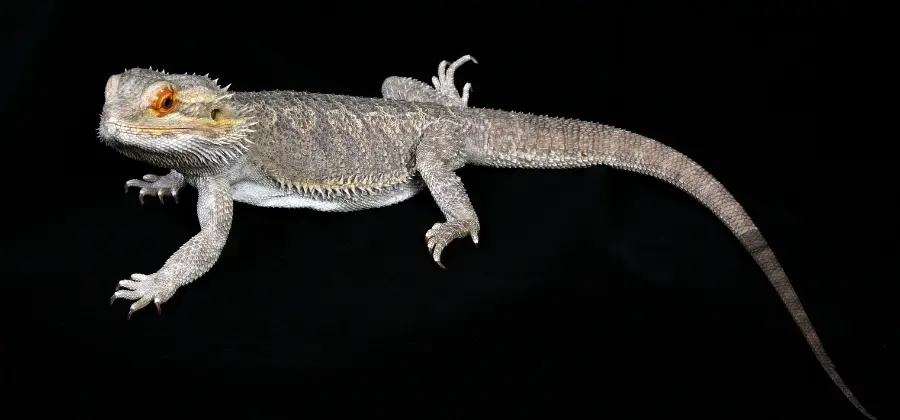
Tail rot is a common issue among bearded dragons, which can lead to severe health problems if not addressed promptly. There are several factors that can contribute to the development of tail rot in bearded dragons, including incomplete shedding, trauma, and bacterial infections.
Incomplete Shed
Incomplete shedding is a major cause of tail rot in bearded dragons. When a bearded dragon fails to shed its skin properly, dead skin can accumulate around the base of the tail. This buildup can constrict blood flow to the tail, causing the tissue to become necrotic and eventually die.
Factors that contribute to incomplete shedding include:
- Inadequate humidity levels in the dragon’s enclosure
- Poor nutrition
- Stress
- Lack of proper basking spots
To prevent incomplete shedding, it’s crucial to provide your bearded dragon with the appropriate environment, diet, and regular monitoring for signs of shedding issues.
Injury
Injuries to the tail can also lead to tail rot in bearded dragons. Trauma to the tail, such as from a bite wound or an object falling on it, can cause a break or fracture. If left untreated, these injuries can lead to infection and eventually, tail rot.
To minimize the risk of injury:
- Monitor interactions between bearded dragons if housed together
- Ensure the enclosure is free of sharp objects or items that may fall
If you notice your bearded dragon has sustained a tail injury, seek veterinary assistance immediately to help prevent the onset of tail rot.
Bacterial Infection
Bacterial infections are another common cause of tail rot in bearded dragons. Bacteria, such as Dermatophilus congolensis, can cause pitted keratolysis and pustular dermatitis on the skin, which can lead to tail rot if not treated promptly.
Prevent bacterial infections by maintaining a clean environment for your bearded dragon and monitoring for signs of infection, such as:
- Swelling or redness around the base of the tail
- Discoloration or an unpleasant odor
- Lethargy or loss of appetite
If you suspect a bacterial infection, consult with a veterinarian to obtain proper treatment and prevent the progression of tail rot.
Home Remedies and Prevention
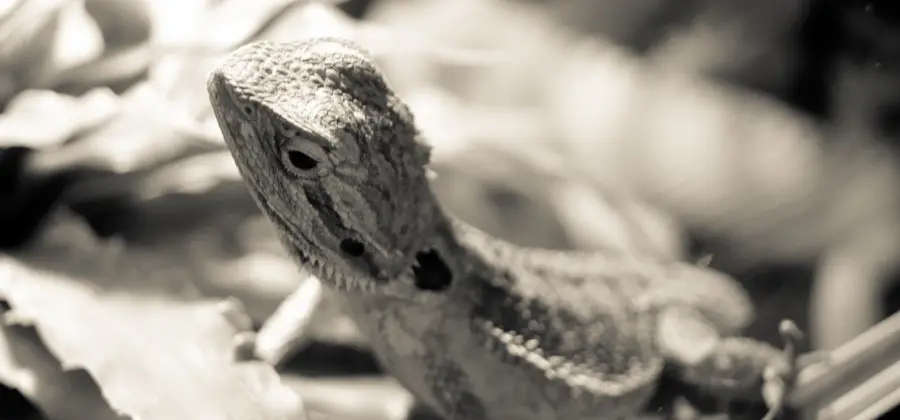
Proper Nutrition
One of the primary factors in preventing bearded dragon tail rot is ensuring proper nutrition. A well-balanced diet, rich in essential nutrients such as calcium and vitamin D, plays a critical role in your reptile’s overall health and well-being.
- Offer a variety of insects, vegetables, and fruits to provide a balanced diet.
- Dust insects with calcium supplements before feeding to ensure your bearded dragon gets enough calcium.
- Make sure to include dark, leafy greens as a staple in their diet, as they are a rich source of calcium.
- Occasional treats of fruit can provide additional vitamins and nutrients.
Correct Lighting
Another essential factor in preventing tail rot in bearded dragons is providing the right type of lighting. Exposure to UVB (ultraviolet B) light enables them to synthesize vitamin D, which is needed for proper calcium absorption.
Here are some guidelines for proper lighting:
- Use a high-quality UVB light that provides the appropriate amount of UVB radiation.
- Replace the UVB light on a regular basis, as recommended by the manufacturer.
- Ensure your bearded dragon has access to the light for at least 10-12 hours per day.
- Keep the light at an appropriate distance from your bearded dragon’s basking spot (usually 8-12 inches).
Safe Enclosure
Proper enclosure management is crucial for the prevention of bearded dragon tail rot and maintaining overall health. A clean and well-maintained environment can significantly reduce the risk of infection.
Consider these guidelines for maintaining a safe enclosure:
- Regularly clean and disinfect the enclosure and its contents to prevent the buildup of bacteria or parasites.
- Ensure proper ventilation within the enclosure to maintain fresh air circulation.
- Provide a basking spot with the correct temperature gradient within the enclosure.
- Provide adequate hiding spots and climbing structures for your bearded dragon to exhibit natural behaviors.
- Ensure the substrate used in the enclosure does not cause injury or irritation to your bearded dragon’s skin or tail.
By focusing on proper nutrition, correct lighting, and maintaining a safe enclosure, you can effectively minimize the risk of tail rot in your bearded dragon and keep them in good health.
Tail Rot- Prevention and Treatment! Watch this
Veterinary Treatments and Intervention
When to Consult a Vet
If you notice any signs of tail rot in your bearded dragon, such as discoloration, swelling, or a foul smell, it’s essential to consult a reptile vet as soon as possible. Delaying treatment may lead to necrosis, tissue loss, and severe infection, which in turn can cause organ failure or even death.
Amputation
In some cases, when the tail rot has progressed significantly and there is extensive necrosis, a vet may recommend amputation as the most effective treatment to prevent the further spread of the disease. The amputation procedure involves:
- Administering anesthesia to the bearded dragon
- Sterilizing the area with a disinfectant, such as betadine
- Removing the necrotic tissue using sterile surgical tools
- Closing the wound with sutures or surgical glue
After the surgery, your bearded dragon will require proper wound care and monitoring to ensure a smooth recovery. Make sure to follow your vet’s guidance for post-operative care.
Antibiotic Treatment
For less severe cases of tail rot, a vet may prescribe antibiotic treatment to help combat the underlying infection. This can include oral medications and topical ointments, such as Neosporin. Keep in mind that it’s crucial to follow your veterinarian’s prescribed treatment plan and dosage instructions.
During the course of antibiotic treatment, it is essential to monitor the bearded dragon’s tail daily for any signs of improvement or worsening.
If you notice any changes, inform your vet immediately. Additionally, maintaining a clean environment for your bearded dragon and providing proper care during this period is crucial in ensuring successful recovery from tail rot.
Timely veterinary intervention and proper care can help save your bearded dragon’s tail and, ultimately, its life. It’s essential to consult a reptile vet if you suspect tail rot and follow the prescribed treatment plan diligently to ensure your bearded dragon returns to full health.
Complications and Prognosis
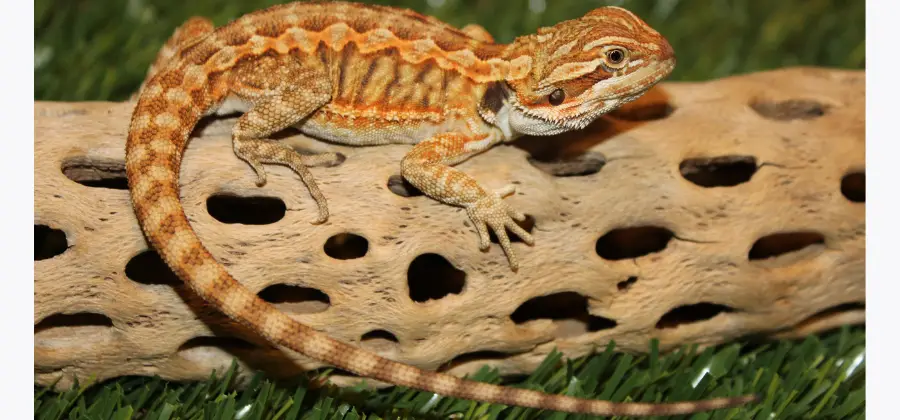
Consequences of Untreated Tail Rot
Bearded dragon tail rot, if left untreated, can lead to a variety of health issues. It begins as localized tissue damage but can quickly progress, causing systemic infections and even life-threatening complications. Some potential consequences of untreated tail rot include:
- Spread of infection: The initial infection can spread along the tail and eventually to other parts of the body, including vital organs. This can cause a systemic infection known as septicemia.
- Necrosis: As the infection progresses, the tail tissue continues to die, causing necrosis. This can become irreversible, and the only treatment option may be amputation.
- Loss of mobility: As the tail rot advances, bearded dragons can experience decreased mobility. Their tails are important for balance, and damage to it may affect their overall movement and ability to function.
Can bearded dragons die from tail rot?
Yes, bearded dragons can die from tail rot if not treated promptly and properly. Tail rot can progress to septicemia, a systemic infection that can be fatal for these reptiles. Systemic infections can cause damage to vital organs, leading to organ failure and ultimately death.
Additionally, severe cases may require amputation of the tail, which can result in stress and complications during the healing process. Early detection and treatment are crucial for the prognosis of tail rot in bearded dragons.
If caught early, appropriate treatment can prevent the spread of infection and minimize long-term consequences.
If you suspect that your bearded dragon has tail rot, it is essential to consult a veterinarian experienced with reptiles to determine the best course of action and provide your pet with the best chance of recovery.
Further Reading and Resources
In order to get reliable and accurate information on bearded dragon tail rot, it is essential to explore trusted resources. The Magonline Library offers an informative article on dermatological diseases in reptiles, including bearded dragons, that can help you better understand tail rot and how to investigate it.
For a comprehensive guide on taking care of a bearded dragon and maintaining its overall health, consider reading “The Bearded Dragon Manual: Expert Advice for Keeping and Caring for a Healthy Bearded Dragon“. This book not only covers health issues but also provides expert advice on feeding, housing, and creating a proper habitat for your pet.
If you’re interested in learning more about the ecology and management of different bearded dragon species, both the western bearded dragon study and the eastern bearded dragon research can provide valuable insights. These resources will also broaden your understanding of their natural habitats and how they’re affected by external factors, such as mining.
For a more general overview of common reptile conditions, BVA In Practice has a useful article on this topic, which can be found here. This resource will be helpful in understanding common ailments that reptiles, including bearded dragons, might face, and how to prevent them.
By exploring these resources, you can gain a deeper understanding of tail rot in bearded dragons, as well as how to keep your scaly companion happy and healthy.
Conclusion
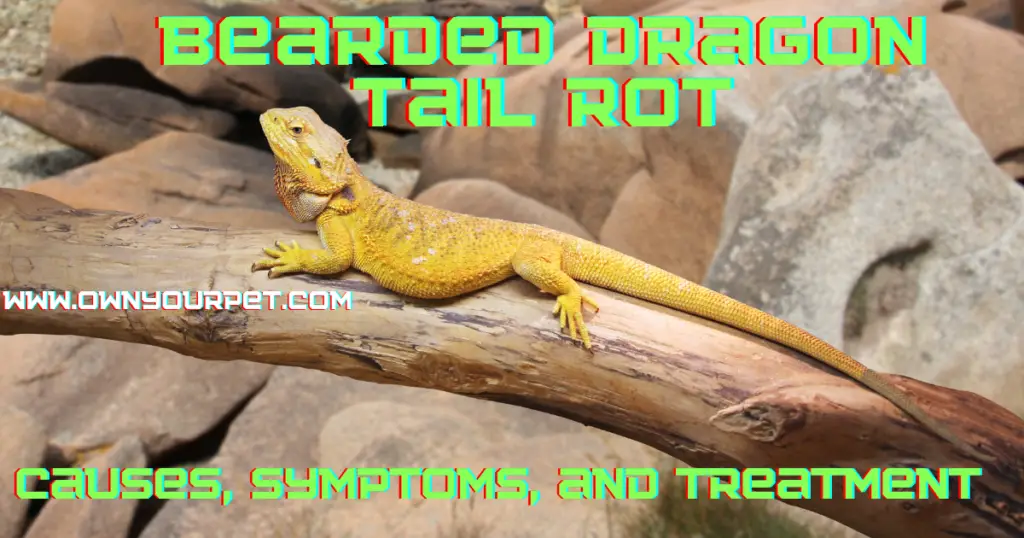
Bearded dragon tail rot is a concerning condition that may affect captive reptiles. It is important to understand the various factors that can contribute to this issue and seek appropriate treatment options for affected animals.
One potential cause of tail rot in bearded dragons is infection. Ensuring a clean and appropriate environment for these reptiles is essential to preventing the spread of infections and promoting overall health. Providing a clean, properly maintained habitat, and conducting regular health checks can go a long way in avoiding tail rot.
In cases where tail rot has already occurred, early detection and immediate intervention are crucial. A veterinary consultation will help determine the best course of action. In some instances, more severe cases may require surgical amputation to prevent the condition from progressing and impacting the bearded dragon’s overall health.
Preventative measures, such as careful handling and reducing stress, are also vital in minimizing the risk of tail rot in bearded dragons. Regularly monitoring their environment, diet, and overall well-being will contribute to a healthier, happier reptile.
In conclusion, maintaining a keen understanding of bearded dragon tail rot is critical in protecting the health of these fascinating pets. By focusing on prevention, early detection, and appropriate intervention, we can significantly reduce the occurrence and impact of this uncomfortable and potentially harmful condition.
FAQs
Q: What is tail rot in bearded dragons?
A: Tail rot in bearded dragons refers to the decay or necrosis of the tail due to factors like injury, infection, or poor hygiene.
Q: What causes tail rot in bearded dragons?
A: Tail rot can be caused by various factors, including injury, bacterial or fungal infections, poor blood circulation, or improper care and husbandry practices.
Q: What are the symptoms of tail rot in bearded dragons?
A: Symptoms of tail rot may include discoloration of the tail, dry or necrotic tissue, foul odor, and potentially secondary infections.
Q: Can tail rot be treated in bearded dragons?
A: Yes, tail rot can be treated. Treatment may involve tail amputation, medical care, proper hygiene practices, and addressing any underlying health issues.
Q: How can bearded dragon owners prevent tail rot?
A: To prevent tail rot, bearded dragon owners should ensure a clean and stress-free environment, provide a healthy and nutritious diet, maintain proper tank size, and seek regular veterinary care.
Q: Is tail rot a serious health concern for bearded dragons?
A: Yes, tail rot can be a serious health concern as it can lead to further infections, impact the overall health of the dragon, and potentially require medical intervention.
Q: What is the role of proper diet in preventing tail rot?
A: A healthy and nutritious diet is essential for bearded dragons as it supports their immune system, promotes proper bone development, and helps maintain overall health, reducing the risk of tail rot.
Q: How can pet owners ensure a healthy tail in their bearded dragons?
A: Pet owners can ensure a healthy tail in their bearded dragons by maintaining good hygiene, providing clean water, offering a high-quality diet, and seeking veterinary care for any signs of infection or disease.
Q: Can tail rot lead to other health complications in bearded dragons?
A: Yes, if left untreated, tail rot can lead to further complications, such as systemic infections, metabolic bone disease, or damage to internal organs.
Q: What should bearded dragon owners do if they suspect tail rot?
A: If tail rot is suspected, it is important for bearded dragon owners to seek veterinary care promptly. A veterinarian can provide a proper diagnosis and recommend appropriate treatment options.

